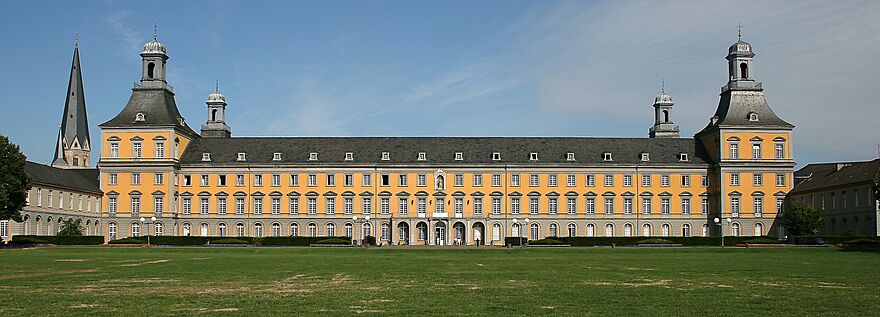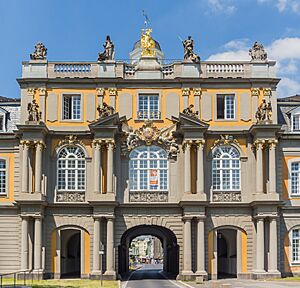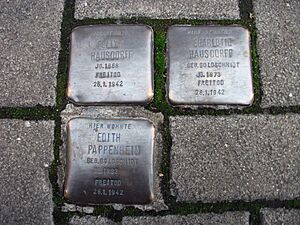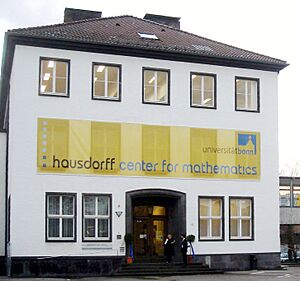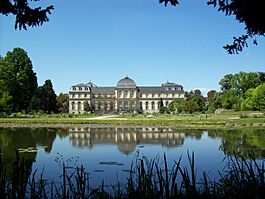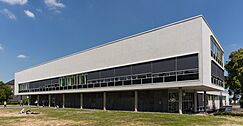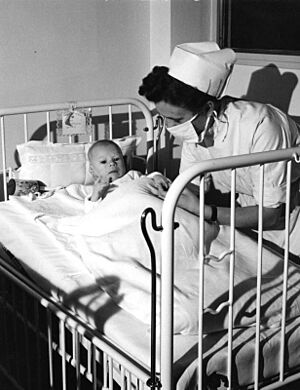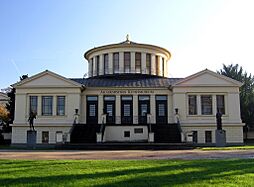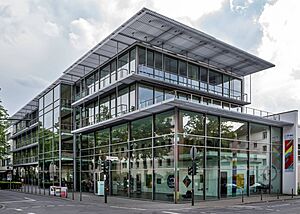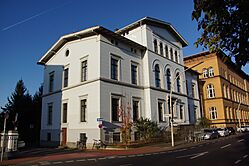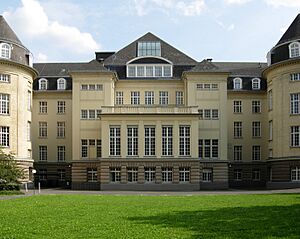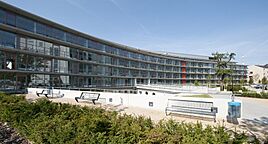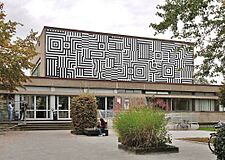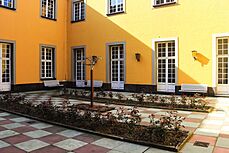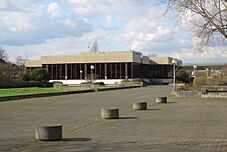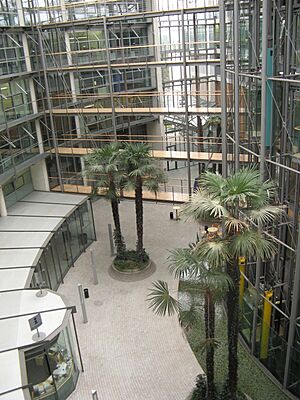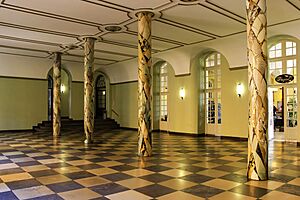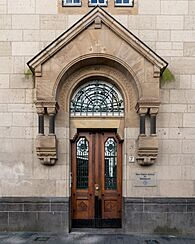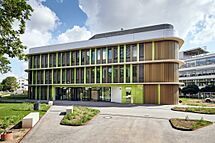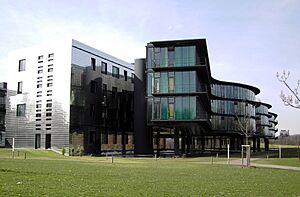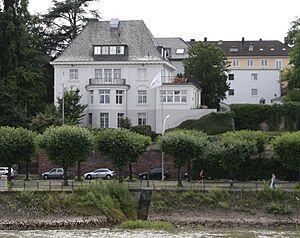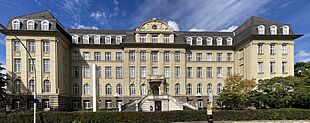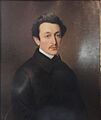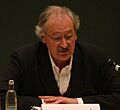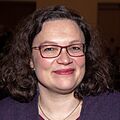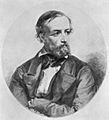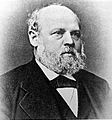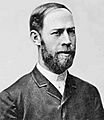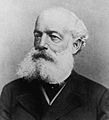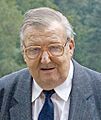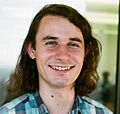University of Bonn facts for kids
|
Rheinische Friedrich-Wilhelms-Universität Bonn (German)
|
|
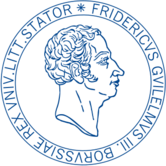
Official university seal
|
|
| Latin: Universitas Fridericia Guilelmia Rhenana | |
| Type | Public |
|---|---|
| Established | 1777 (as Kurkölnische Akademie Bonn); Foundation: 18 October 1818 |
| Budget | €850,2 million (without the university hospital) |
| Rector | Michael Hoch |
|
Academic staff
|
4,537 |
|
Administrative staff
|
1,759 |
| Students | 35,619 |
| Location |
,
Germany
|
| Campus | Urban |
| Colors | Blue, yellow, grey |
| Affiliations | EUA, German U15, FGU, Erasmus, Excellence Initiative |
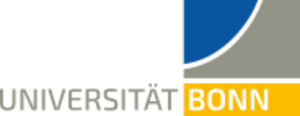 |
|
The University of Bonn is a big public research university in Bonn, Germany. Its full name is the Rhenish Friedrich Wilhelm University of Bonn. It was officially started on October 18, 1818. This university grew from an older school called the Academy of the Prince-elector of Cologne, which began in 1777.
The University of Bonn offers many different study programs. It has over 500 professors teaching a wide range of subjects. It is part of the German U15 association, which includes Germany's top research universities. It also has the special title of "University of Excellence."
Bonn is home to six "Clusters of Excellence." These are special research groups that focus on important topics. They include math, quantum computing, slavery studies, crop production, the immune system, and economics. The university's main library, the University and State Library Bonn, has over five million books.
Many famous people have studied or taught at the University of Bonn. These include 11 Nobel Prize winners and 5 Fields Medalists (a top award in math). Famous scientists like August Kekulé and Heinrich Hertz were here. Important thinkers like Karl Marx and Friedrich Nietzsche also studied here. Even famous leaders like Konrad Adenauer and Pope Benedict XVI were part of the university.
Contents
History of the University
How it Started
The university's first version was the Academy of the Prince-elector of Cologne. It was founded in 1777 by Maximilian Frederick of Königsegg-Rothenfels. He was also one of the first people to hire the famous composer Beethoven. This early academy was open to everyone, no matter their religion. It had schools for theology, law, pharmacy, and general studies.
In 1784, Emperor Joseph II allowed the academy to give out degrees. This made it a real university. But the academy closed in 1798 when France took over the area during the French Revolutionary Wars.
In 1815, the Rhineland area became part of Prussia. King Frederick William III of Prussia decided to open a new university there. This happened on October 18, 1818. At that time, there were no universities left in the Rhineland. The University of Bonn was chosen because it had a history of being open to all religions.
The Rhine University Era
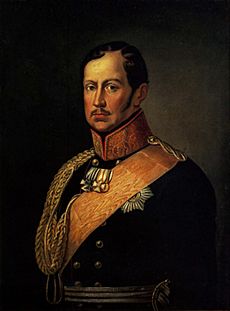
The new Rhine University was founded by Frederick William III. It was the sixth university in Prussia. It was designed to be fair to both Christian groups. It had schools for Catholic and Protestant theology, medicine, law, and philosophy. At first, 35 professors taught there.
In 1827, the university got its own rules. These rules focused on the university being independent. They also stressed that teaching and research should go together. This made the University of Bonn a modern research university.
Soon after, some political problems affected universities in Germany. A student murdered a writer, which led to strict new rules. One professor, Ernst Moritz Arndt, was even banned from teaching for a while. The university also didn't get an official name until 1840. That's when King Frederick William IV of Prussia named it the Rhenish Friedrich-Wilhelms-Universität.
Despite these challenges, the university grew. Many sons of the Prussian king studied here, earning it the nickname "Princes' university." By 1900, it had many professors. In 1908, women were fully allowed to study at the University of Bonn.
World Wars and Beyond
World War I slowed the university's growth. After the war, money problems meant less government funding. The university looked for help from private companies. In 1930, students were allowed to help run the university for the first time.
However, when the Nazis took power in 1933, things changed. The university was forced to follow Nazi rules. Jewish professors and students were kicked out. The mathematician Felix Hausdorff was expelled and later died. The university suffered a lot of damage during World War II, especially from an air raid in 1944.
After the War to Today
The university reopened on November 17, 1945. It was one of the first in the British occupation zone. Many students wanted to attend, but there were limited spots.
The university grew a lot after the war. The university hospital moved to a new location in 1949. A new library opened in 1960, and a new building for law and economics opened in 1967.
In 1980, another university, the Pedagogical University Bonn, joined the University of Bonn. In 1989, Wolfgang Paul won the Nobel Prize in Physics. Three years later, Reinhard Selten won the Nobel Prize in Economics. When the German capital moved from Bonn to Berlin in 1991, Bonn received money to build new research institutes. These institutes work closely with the university.
In the 2000s, the university changed its degree programs. It switched from older German degrees to the Bachelor and Master programs we know today. This was finished by 2007.
University Campus and Buildings
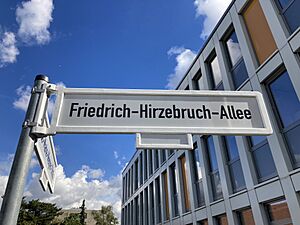
The University of Bonn doesn't have one main campus. Its buildings are spread out across the city. The main building is the Kurfürstliches Schloss. This used to be a palace for the prince-elector of Cologne. Today, it holds humanities and theology departments, plus university offices. The Hofgarten, a large park in front of the palace, is a popular spot for students.
The law and economics schools, the main library, and other departments are in modern buildings nearby. Science departments are located in Poppelsdorf and Endenich. The beautiful Poppelsdorf Palace is one of these buildings. It was built between 1715 and 1753. Now, it houses the university's mineral collection and science departments. Its gardens are the university's botanical garden.
The medical school is on Venusberg, a hill on the edge of Bonn. Student housing is found throughout the city. In total, the University of Bonn owns 371 buildings.
University Library
The university library started in 1818 with 6,000 books. It grew over time, but about 200,000 books were destroyed in an air raid in 1944. After the war, a new central library opened in 1960. Another library for science, agriculture, and medicine opened in 1983. Today, the university library system has 2.2 million books and subscribes to about 14,000 journals.
University Hospital
The university hospital opened in 1819. It started small, with only thirty beds. From 1872 to 1883, it moved to new buildings in the city center. After World War II, it moved to Venusberg. Since 2001, the hospital has been independent but still works closely with the university's School of Medicine. Today, it has about thirty hospitals and treats many patients.
University Museums
The Akademisches Kunstmuseum (Academic Museum of Antiquities) was founded in 1818. It has one of the world's largest collections of plaster casts of ancient Greek and Roman sculptures. These casts were used to teach students about art.
The Egyptian Museum opened in 2001. Its collection dates back to the 1800s. The Arithmeum opened in 1999. It has the world's largest collection of old mechanical calculating machines. It works with the Research Institute for Discrete Mathematics.
The Teaching Collection of Archaeology and Anthropology opened in 2008. It has over 7,500 objects, mostly from before Christopher Columbus.
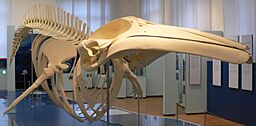
The Botanical Garden officially started in 1818. It's located around the Poppelsdorf Palace. A garden has been there since at least 1578. In 2003, the world's largest titan arum flower bloomed here.
The natural history museum opened in 1820. It was the first public museum in the Rhineland. It later split into the Mineralogical Museum and the Goldfuß Museum.
The Horst Stoeckel-Museum of the History of Anesthesiology opened in 2000. It is the largest of its kind in Europe.
The Museum Koenig is one of Germany's largest natural history museums. It is connected to the university. It was founded in 1912 by Alexander Koenig.
University Organization
The University of Bonn has about 32,500 students, with 4,000 of them from other countries. Each year, about 3,000 students earn their first degrees. The university also awards about 800 Ph.D.s. It offers over 90 different study programs. Some of its strongest areas are math, physics, law, economics, and agriculture. The university has over 550 professors and a large staff.
University Departments
From 1818 to 1928, the university had five main departments. These included Catholic Theology, Protestant Theology, Law, and Arts and Science. Over time, new departments were added or combined. Today, the university has seven main departments.
Protestant Theology
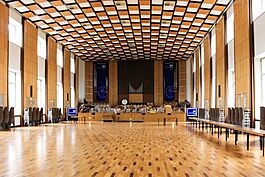
The Protestant Theology department has been at the university since 1818. It focuses on different areas of theology, like historical and ecumenical theology. It is located in the main university building. It is the smallest department at the University of Bonn, with 187 students.
Catholic Theology
The Catholic Theology department also started in 1818. It has 13 different areas of study. A special part of this department is its work on theological gender research. It is also a smaller department, with 243 students. Pope Benedict XVI taught here from 1959 to 1963.
Agriculture
In 1934, the Agriculture department was created. It came from an older Agricultural University in Poppelsdorf. Today, it focuses on topics like farming systems, food science, and animal science. Students can study Agricultural Sciences, Nutritional Sciences, and Animal Sciences. This department is located on the Poppelsdorf campus and has about 2,500 students.
It includes seven different institutes, covering areas like food, geodesy, agricultural engineering, and animal sciences.
Mathematics and Natural Sciences
The Mathematics and Natural Sciences department includes math, computer science, physics, astronomy, chemistry, earth sciences, biology, and pharmacy. It was formed in 1936. With 7,636 students, it is one of the largest departments. Its buildings are in different parts of Bonn.
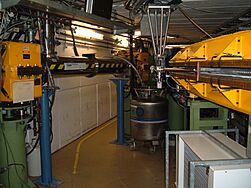
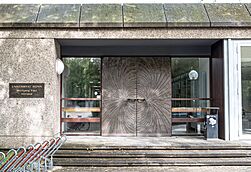
The Math section includes several institutes. The Hausdorff Center for Mathematics is a special research center here. Famous mathematicians like Peter Scholze have studied and taught in this department. It also works with top universities around the world.
The Computer Science section includes the Institute of Computer Science. It shares a computer science center on the Poppelsdorf campus.
The Physics-Astronomy section includes institutes for physics and astronomy. They work with the University of Cologne on a special physics and astronomy program. The Institute of Physics operates a particle accelerator called ELSA. The Argelander Institute for Astronomy is named after the astronomer Friedrich Wilhelm August Argelander.
The Old Chemical Institute, built in the 1860s, was once the largest institute building in the world. Today, it houses microbiology and geography. The Biology section has eight institutes. It also works with the Museum Koenig and the Botanical Gardens.
The Steinmann Institute for Geology, Mineralogy, and Paleontology combines several earth science fields. It also includes the Mineralogical Museum and the Goldfuß Museum.
Medicine
The Medicine department focuses on brain science, genetics, heart diseases, and the immune system. It works closely with the University Hospital Bonn. Most of its buildings are on Venusberg. About 2,699 students study here.
Law, Economics, and Social Sciences
This department moved into its new building, the Juridicum, in 1967. It has about 5,000 students and includes law and economics.
The Law section has many institutes for teaching. It also has a center for European business law.
The Economics section has three institutes and several research centers. Famous economists like Isabel Schnabel and Nobel Prize winner Reinhard Selten are part of this department. It also works with the University of California, Berkeley.
Arts
The Arts department is the largest at the university, with over 8,753 students. It includes English studies, history, German studies, philosophy, psychology, archaeology, and art history.
The first German art history professor was appointed here in 1860. The department works with the University of Cologne for some courses. It also has several interdisciplinary centers for different cultural studies.
Student Life
The Bonn Studentenwerk (Student union) helps students with things like food, housing, and financial aid. It's one of the oldest in Germany. Students can also join many clubs, like the university radio station, a Shakespeare company, a debating club, and various sports clubs.
University Sports
The University of Bonn has a large sports program. It offers about 200 sports activities at 38 locations around the city. It also has its own gyms.
Rowing is a very important sport at the university. The rowing team has its own boathouse on the Rhine River. They compete in regattas across Germany and often do well in national university championships.
Academic Exchange
The Erasmus program lets students study at over 300 European universities. The Global Exchange Program allows students to study for free at non-European partner universities.
In 2022, Bonn students could exchange with many leading universities worldwide. These included universities in the USA, Australia, China, Japan, and many European countries.
Future Plans
Infrastructure
The university is investing a lot of money to update its buildings. A new 'Teaching and Research Forum' is being built for economics and math. A research building for the Museum Koenig is also being completed. This will help the museum and biology department work together more. A new chemistry building is also under construction.
The Akademisches Kunstmuseum is being renovated and will be finished by 2025. The main building, the Electoral Palace, is also getting a big renovation. This will take several years and be completed by 2030. While it's being worked on, humanities departments are in a temporary building. A 'Forum of Knowledge' will also be added to the main building.
International Goals
The University of Bonn wants to become even more international. Since 2015, it has created international research areas and excellence clusters. It also has many international research projects.
By 2025, the university aims to have more international professors. It wants to increase international research projects and get more funding from the European Union. It also plans to build a global network with partner universities. This includes focusing on cooperation with countries in Africa, Asia, and Latin America.
The university also wants to make its study programs more international. This means offering more English-language courses. It aims to increase the number of international exchange students coming to Bonn. It also wants more Bonn students to study abroad. The university is working to make its services more bilingual and improve foreign language skills for its staff.
The university also plans to work more with the United Nations University and other international groups in Bonn. It wants to cooperate more with local businesses and the City of Bonn.
Academic Profile
Research Institutes
The Franz Joseph Dölger-Institute studies ancient times. It looks at how Christians, Jews, and Pagans interacted. The institute is named after a theology professor.
The Research Institute for Discrete Mathematics focuses on math used in computer science. It works with companies like IBM and Deutsche Post. Researchers from this institute helped optimize the chess computer IBM Deep Blue.
The Bethe Center for Theoretical Physics brings together physicists and mathematicians. It helps with research in many areas of theoretical physics.
The German Reference Center for Ethics in the Life Sciences helps people find scientific information about ethics in biology and medicine. It's the only one of its kind in Germany.
After the German capital moved from Bonn to Berlin, three new research institutes were founded in 1995. Two of them are connected to the university:
- The Center for European Integration Studies studies how European countries work together.
- The Center for Development Research looks at global development from different angles.
The Institute for the Study of Labor is a private research institute. It focuses on labor economics and advises on job market issues. It works closely with the university's economics department.
The Max Planck Institute for Mathematics is part of a network of research institutes in Germany. It was founded in 1980 by Friedrich Hirzebruch. The Max Planck Institute for Radio Astronomy was founded in 1966. It operates a large radio telescope.
The Max Planck Institute for Research on Collective Goods studies how groups make decisions.
The Center for Economics and Neuroscience was founded in 2009. It helps researchers study how the brain affects economic decisions.
Research Discoveries
University of Bonn researchers have made important discoveries in science and humanities. In physics, they helped develop the quadrupole ion trap and discovered radio waves. In chemistry, they helped understand important chemical structures like Benzene. In math, they made key contributions to modern topology and algebraic geometry. Many math concepts are named after Bonn mathematicians. Economists from Bonn have also made big contributions to game theory.
The university has many research centers funded by the German Science Foundation. It receives over 75 million Euros in research funding each year.
In 2006, the German government started the Excellence Initiative. This led to the creation of the Hausdorff Center for Mathematics. It also expanded the Bonn Graduate School of Economics. The Excellence Initiative also helped create the Bonn-Cologne Graduate School of Physics and Astronomy.
University Rankings
| University rankings | ||||||||||
|---|---|---|---|---|---|---|---|---|---|---|
| Overall – Global & National | ||||||||||
|
||||||||||
| By subject – Global & National | ||||||||||
|
||||||||||
The University of Bonn is highly ranked among universities worldwide. In 2024, it was ranked 239th globally and 14th in Germany by QS World University Rankings. Times Higher Education ranked it 91st worldwide and 6th in Germany in 2024. The Academic Ranking of World Universities placed it 67th globally and 4th in Germany in 2023.
For Mathematics, the University of Bonn is especially strong. It was ranked 39th globally and 1st in Germany by QS in 2023. ARWU also ranked it 15th in the world and 1st in Germany for Mathematics in 2022.
|
|
|||||||||||||||||||||||||||||||||||||||||||||||||||||||||||||||||||||||||||||||||||||||||||||||||||||||||||||||||||||||||||||||||||||||||||||||||||||||||||||||||||||||||||||||||||||||
Partner Universities Around the World
The University of Bonn works with many well-known universities globally. In 2023, Bonn started a new global network. This network includes Emory University, Hebrew University of Jerusalem, University of St Andrews, and Waseda University. They work together on education, research, and new ideas.
Africa
- Ghana: University of Ghana, KNUST.
- Kenya: University of Nairobi.
- Morocco: Mohammed V University.
Asia and Oceania
- Australia: Australian National University, University of New South Wales, University of Melbourne
- China: Peking University, Beijing Language and Culture University, Beijing Foreign Studies University, Nanjing University, Shanghai Jiao Tong University, Tongji University
- Hong Kong: Chinese University of Hong Kong, University of Hong Kong
- Japan: Keio University, Rikkyo University, Sophia University, University of Tsukuba, Kyoto University, Waseda University, University of Tokyo
- Singapore: National University of Singapore
- South Korea: Korea University, Seoul National University, Sogang University
- Taiwan: National Chengchi University, National Taiwan University, Tamkang University
Europe
- Czechia: Charles University.
- France: Collège de France, Paris Sciences et Lettres University, Paris-Saclay University, Sorbonne University, University of Strasbourg, University of Toulouse
- Italy: University of Florence.
- Luxembourg: University of Luxembourg.
- Netherlands: Wageningen University & Research.
- Poland: Cardinal Stefan Wyszyński University in Warsaw, Warsaw University of Life Sciences, University of Warsaw, University of Wrocław.
- Spain: Autonomous University of Barcelona, University of Barcelona, University of León, University of Salamanca.
- Switzerland: University of Basel.
- United Kingdom: University of St Andrews, University of Warwick, University of Oxford.
North and South America
- Brazil: Pontifical Catholic University of Rio de Janeiro, Federal University of Rio de Janeiro
- Chile: University of Talca, Pontifical Catholic University of Chile, University of Chile
- Canada: University of British Columbia, University of Northern British Columbia, University of Ottawa, University of Toronto, McGill University, York University
- Mexico: Meritorious Autonomous University of Puebla
- United States of America: Emory University, Kalamazoo College, Louisiana State University, Ohio State University, Stony Brook University, University of California, Berkeley, University of Florida, University of Kansas, University of Missouri–St. Louis, University of New Mexico, University of Southern Mississippi, University of Mississippi, University of Tennessee, University of Wisconsin–Madison, Washington State University
Middle East
- Afghanistan: Kabul University.
- Israel: Hebrew University of Jerusalem, Technion, Reichman University, Weizmann Institute of Science.
Regional Networks
- ABCD-J: RWTH Aachen, University of Cologne, Heinrich Heine University Düsseldorf, Forschungszentrum Jülich
- Bonn-Frankfurt-Mainz: Goethe University Frankfurt, University of Mainz
Subject Specific Networks
Bonn also has strong international research connections in specific subjects:
- GlobalMathNetwork: École Normale Supérieure, New York University, Kyoto University, Peking University, University of Warwick, Berkeley, Princeton University
- European Doctoral Programme in Quantitative Economics: Pompeu Fabra University, European University Institute, London School of Economics, KU Leuven, HEC Paris, Tel Aviv University
- TAKeOFF: LMU Munich, KNUST, Tanzania Institute for Medical Research, University of Buea
- Agricultural Innovation: LMU Munich, University of Hohenheim, FARA, AGRODEP
- European Culture and Identity: Sorbonne University, University of Florence, University of Toulouse, University of St Andrews, University of Salamanca, University of Warsaw, University of Freiburg, Sofia University, University of California, Irvine
- UN-Bonn-Tokyo: United Nations University
Notable People from Bonn University
Many famous people have been part of the University of Bonn. So far, 11 Nobel Prizes and 5 Fields Medals have been awarded to people who studied or worked here:
- Nobel Prize Winners:
- Emil Fischer, alumni: chemistry, 1902
- Jacobus Henricus van 't Hoff, alumni: chemistry, 1901
- Harald zur Hausen, alumni: physiology and medicine, 2008
- Walter Rudolf Hess, faculty member: physiology and medicine, 1949
- Reinhard Selten, faculty member: economics, 1994
- Wolfgang Paul, faculty member: physics, 1989
- Luigi Pirandello, alumni: literature, 1934
- Otto Wallach, faculty member: chemistry, 1910
- Paul Johann Ludwig von Heyse, alumni: literature, 1910
- Philipp Lenard, faculty member: physics, 1905
- Reinhard Genzel, alumni: physics, 2020
- Fields Medal Winners:
- Gerd Faltings, 1986
- Maxim Kontsevich, 1998
- Gregori Margulis, 1978
- Peter Scholze, 2018
- Maryna Viazovska, 2022
Here are some other well-known people from the University of Bonn:
- In Humanities:
-
Konrad Adenauer was Chancellor of Germany from 1949 to 1963
-
Ernst Moritz Arndt
Historian, writer, and poet -
Pope Benedict XVI
Head of the Catholic Church -
Ludwig van Beethoven
Composer and pianist -
Max Bruch
Composer and conductor -
Franz Boas
Anthropologist -
Heinrich Brüning
Chancellor of Germany from 1930 to 1932 -
Ludwig Erhard
The second Chancellor of West Germany -
Walter Eucken
Economist -
Frederick III
German Emperor -
Jürgen Habermas
Philosopher and sociologist -
Heinrich Heine
Poet and writer -
Oskar Lafontaine
Politician -
Armin Laschet
Politician -
Christian Lindner
Party leader of the FDP -
Nobel Prize-winning novelist Thomas Mann
-
Karl Marx
Philosopher, economist, and revolutionary -
Andrea Nahles
Politician -
Friedrich Nietzsche
Philosopher and poet -
Thilo Sarrazin
Politician and writer -
Robert Schuman
Statesman and a founder of the European Union -
Joseph Schumpeter
Economist -
Carl Schurz
German revolutionary and American statesman -
Ferdinand Tönnies
Sociologist and philosopher -
Guido Westerwelle
Foreign Minister of Germany -
Wilhelm II of Germany
German Emperor
- In Natural Sciences:
-
Friedrich Wilhelm August Argelander
Astronomer -
Constantin Carathéodory
Mathematician -
Peter Gustav Lejeune Dirichlet
Mathematician -
Gerd Faltings
Mathematician -
Emil Fischer
Organic Chemist -
Heinrich Geißler
Physicist and Inventor -
Reinhard Genzel
Astrophysicist -
Felix Hausdorff
Mathematician -
Harald zur Hausen
Virologist -
Heinrich Hertz
Physicist -
Friedrich Hirzebruch
Mathematician -
Eduard Heine
Mathematician -
Walter Rudolf Hess
Physiologist -
August Kekulé
Organic chemist -
Jacobus Henricus van 't Hoff
Physical and Organic Chemist -
Felix Klein
Mathematician -
Philipp Lenard
Physicist -
Justus von Liebig
Founder of organic chemistry -
Rudolf Lipschitz
Mathematician -
Grigory Margulis
Mathematician -
Hermann Minkowski
Mathematician and Physicist -
Wolfgang Paul
Physicist -
Julius Plücker
Mathematician and Experimental Physicist -
Peter Scholze
Mathematician -
Maryna Viazovska
Mathematician -
Otto Wallach
Organic Chemist -
Karl Weierstrass
Mathematician
See also
 In Spanish: Universidad de Bonn para niños
In Spanish: Universidad de Bonn para niños
- List of early modern universities in Europe


